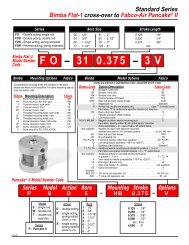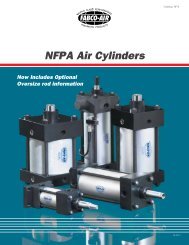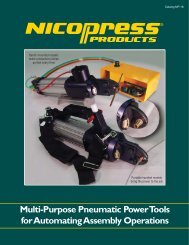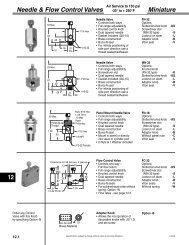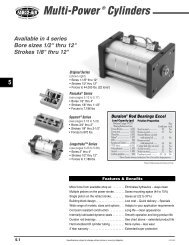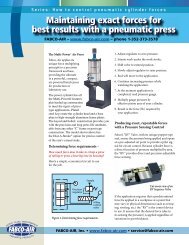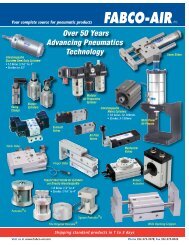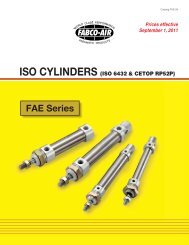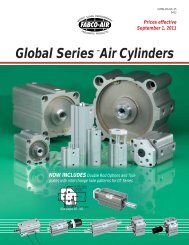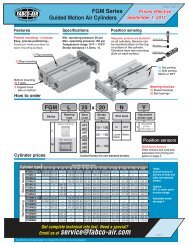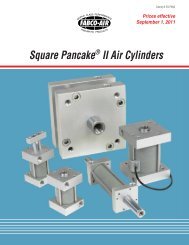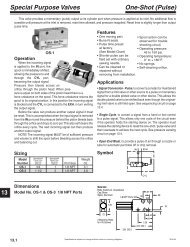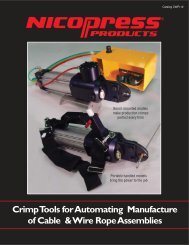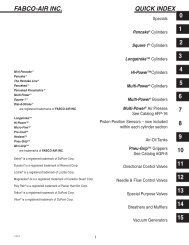Rivet, Hole Punch, & Broaching - Fabco-Air, Inc.
Rivet, Hole Punch, & Broaching - Fabco-Air, Inc.
Rivet, Hole Punch, & Broaching - Fabco-Air, Inc.
Create successful ePaper yourself
Turn your PDF publications into a flip-book with our unique Google optimized e-Paper software.
How to control pneumatic cylinder forces<br />
Using Pneumatic Cylinders in <strong>Rivet</strong>,<br />
<strong>Hole</strong> <strong>Punch</strong> & <strong>Broaching</strong> applications<br />
FABCO-AIR – www.fabco-air.com – phone 1-352-373-3578<br />
Begin with force-multiplying<br />
Pneumatic Cylinders<br />
Multi-Power® <strong>Air</strong> Cylinders from <strong>Fabco</strong>-<strong>Air</strong><br />
provide the high forces necessary in applications<br />
such as riveting, hole punching and broaching.<br />
The cylinders operate on the principle of attaching<br />
multiple pistons to a common shaft with an internal<br />
air passage to all pistons. In this way, a Multi-<br />
Power® cylinder (depending on a 2, 3 or 4 piston<br />
unit) can achieve roughly 2, 3 or 4 times the force<br />
output of a conventional single piston cylinder.<br />
Multi-Power® cylinders are available in ten bore<br />
sizes and can create forces up to 44,000 lbs. of<br />
force rivaling many hydraulic systems! They are<br />
easy to install having only two port connections.<br />
2-piston Multi-Power®<br />
cylinder with clevis mount<br />
Male rod<br />
extension<br />
Retract port<br />
<strong>Air</strong> vent slot in<br />
baffle plate<br />
Extend port<br />
Today's application requires 4800 lbs of force for<br />
upsetting a rivet holding a stack of laminations<br />
together. Dividing 4800 lbs by 90 psi (our standard<br />
shop air supply), we will require 53.3 in2 . of piston<br />
area to do the job.<br />
From Figure 1, Cylinder Selection Guide, we see<br />
that two standard Multi-Power® cylinders meet<br />
the piston area requirements: a 5" bore 3-piston<br />
(3-stage) cylinder has 56. 4-in2 .; a 6" bore 2-stage<br />
unit has 55.3-in2 . At 90 psi, both will yield forces<br />
beyond our needs.<br />
Figure 1 - Cylinder Selection Guide<br />
Controlling speed and shock when<br />
punching holes<br />
<strong>Hole</strong>s could also be punched in the laminations<br />
using a Multi-Power® cylinder. If needed, we can<br />
get as much as 39,843 lbs force at 90 psi supply<br />
pressure from a 12 in. bore, 4-stage cylinder. But<br />
it is important that we make accommodations for
Controlling speed and shock when punching holes<br />
FABCO-AIR – www.fabco-air.com – phone 1-352-373-3578<br />
the inertial and impact forces that will be released<br />
when our tooling breaks through the work piece.<br />
To capture these potentially destructive forces,<br />
and prevent damage to the cylinder and tooling,<br />
an air-over-oil tank is incorporated in the circuit<br />
between the directional control valve and the<br />
cylinder return port. (Figure 2)<br />
How it works–<br />
Fluid in the tank is used for the cylinder's return<br />
media only. Fluid flow and cylinder speed are<br />
controlled by a needle or flow control valve. In<br />
our example we have chosen a flow control valve<br />
because we want to control the speed of the "work"<br />
stroke while allowing a full speed retract stroke.<br />
When the material shears and the cylinder tries to<br />
complete the stroke, the non-compressible fluid<br />
resists rapid movement. It "catches" the built up<br />
forces, dissipating them before the cylinder can<br />
bottom out. Thus the piston won't "pound" on<br />
the piston stop. AO-11<br />
ONE SPEED & Shock<br />
<strong>Air</strong> Supply<br />
Muffler<br />
Directional Control<br />
4-Way <strong>Air</strong> Valve<br />
Single Tank<br />
<strong>Air</strong>-over- Oil<br />
Flow Control Valve<br />
Power Cylinder<br />
Figure 2 - <strong>Air</strong>-over-oil shock control circuit<br />
Hydraulic Shock option–<br />
Seals on the piston, piston rod, and cylinder tube<br />
are increased in the single-stage retract section<br />
(Shown yellow in Figure 3). Dynamic Poly-Pak ®<br />
seals combine an automatic lip type seal with an<br />
O-spring energizer for excellent sealing from zero<br />
to 500 psi. Piston thickness is increased.<br />
Thicker Piston<br />
Standard<br />
Piston Seal<br />
Additional<br />
Polypak®<br />
Piston Seal<br />
Additional<br />
Tube Seal<br />
Liquid to and<br />
from tank<br />
Additional<br />
Polypak®<br />
Rod Seal<br />
Figure 3 - Beefed up construction<br />
Bronze<br />
Bushing<br />
Determining force requirements –<br />
How much force does it take to crimp a piece<br />
of tubing or press a bearing into its housing?<br />
Here's a simple, economical circuit to use<br />
for the job:<br />
1. Adjust regulator to zero pressure.<br />
2. Situate work under the work stroke.<br />
3. Shift valve to extend position.<br />
4. Slowly adjust regulator to raise pressure.<br />
5. Rod will move to the application.<br />
6. Continue increasing pressure while<br />
watching the application.<br />
7. At the moment application is<br />
completed, read pressure gauge.<br />
8 Multiply gauge pressure by<br />
effective piston area of your cylinder<br />
(find piston areas in a "Selection Guide."<br />
Sample guide shown in Figure 1, page 1)<br />
9. Result is the force (lb.) required by<br />
FTR2<br />
your application.<br />
Precision<br />
regulator<br />
Supply<br />
4-Way<br />
control<br />
valve<br />
Figure 4 - Determining force requirements
Controlling force and shock when punching holes<br />
FABCO-AIR – www.fabco-air.com – phone 1-352-373-3578<br />
Producing exact, repeatable forces with<br />
a Pressure Sensing Control<br />
<strong>Fabco</strong>'s “RV” Valve, with its unique poppet type<br />
seal, senses the pressure being applied and opens<br />
at a pre-adjusted set point to provide a pilot<br />
signal for circuit control. Because force is a direct<br />
function of pressure multiplied by area, the “RV”<br />
provides direct and precision adjustable force<br />
sensing.<br />
If the application requires that a predetermined<br />
force be applied to an object at a point that may<br />
vary in physical dimensions (such as crimping,<br />
riveting, etc.) the “RV” is the control to use. It assures<br />
that the desired force (due to its sensing the<br />
pressure) is applied regardless of variations in part<br />
thickness.<br />
Cut-away view of an<br />
RV Sequence Valve<br />
If system pressure should drop below the “RV’s”<br />
set point, it cannot open. The cycle will hold and<br />
wait for the required pressure rather than produce<br />
an unacceptable rivet or crimp.<br />
Once pressure is restored, the cycle will continue.<br />
The part that had been under the work stroke will<br />
be finished as a "good part". The pressure gauge<br />
confirms the sensed pressure.<br />
Symbol for a 2-stage<br />
Multi-Power® press<br />
Gauge<br />
Start<br />
signal<br />
Pressure sensing<br />
sequence valve<br />
Figure 5 - Producing exact forces<br />
Regulated<br />
supply<br />
Two speed work stroke<br />
with shock control<br />
A single air/oil tank with a sequence, needle and<br />
shut-off valves, as shown in Figure 6, provides us<br />
with 2-speed work stroke operation.<br />
The sequence is as follows:<br />
1. Rapid "extend" stroke to approach the work.<br />
2. Automatic switch to controlled rate when<br />
resistance is met and pressure builds up to the<br />
point where a <strong>Fabco</strong>-<strong>Air</strong> RV "Sequence Valve"<br />
actuates the 2-way shut-off valve forcing fluid<br />
flow through the speed controlling needle valve.<br />
Sequence<br />
Valve<br />
actuates<br />
when set<br />
pressure<br />
reached<br />
<strong>Air</strong> supply<br />
Needle<br />
Valve<br />
Power Cylinder<br />
Single<br />
<strong>Air</strong>/Oil Tank<br />
Figure 6 - 2-Speed work stroke circuit<br />
Shut-o,<br />
2-way, oil<br />
3. Fluid catches cylinder, again as described in<br />
our previous hole punching application, thus<br />
controlling the shock that could otherwise occur.<br />
4. Automatic return to rapid rate on<br />
"Cylinder Retract" stroke.
Expanding the Multi-Power® concept<br />
FABCO-AIR – www.fabco-air.com – phone 1-352-373-3578<br />
Multi-Power® Principle applied<br />
to other devices<br />
Multi-Power® <strong>Air</strong> Presses –<br />
<strong>Fabco</strong>-<strong>Air</strong> applies its unique Multi-Power®<br />
principle to a precision framework and base,<br />
providing the ultimate in a powerful, compact,<br />
air-powered bench press for production or<br />
laboratory use.<br />
The power cylinder has all the Multi-Power®<br />
features plus beefed up construction to meet<br />
the rigors of press type applications. Plated steel<br />
keys mate the cylinder head and a base plate to<br />
high-strength aluminum frame plates. The keyed<br />
and bolted construction provides you with the<br />
precision and long press life unobtainable from<br />
any other "C" frame or post type construction.<br />
Model F55 press with 3-stage power cylinder<br />
Multi-Power® Assembly Tool –<br />
Hand-held or bench-mounted pneumatic tools<br />
can perform numerous manufacturing functions:<br />
make plumbing assemblies; splice wire rope and<br />
cable; crimp electrical components; swage mechanical<br />
fasteners; stake, punch, pierce and flare;<br />
seal, emboss and notch; clamp and hold assemblies<br />
and more.<br />
Bench mounted Assembly Tool<br />
Multi-Power® Linear Slides –<br />
Applying the Multi-Power® principle to linear<br />
slides increases slide thrust without increasing the<br />
bore or the mounting footprint. Shown below is a<br />
<strong>Fabco</strong>-<strong>Air</strong> slide model SE1000, utilizing a 4-stage<br />
Multi-Power® cylinder capable of producing 1,830<br />
pounds extend force at 100 psi supply pressure.<br />
A conventional cylinder would yield only 491<br />
pounds force at the same supply pressure.<br />
Model SE1000 4-stage,<br />
2-1/2" bore linear slide
about<br />
FABCO-AIR<br />
Useful option for Multi-Power® devices<br />
FABCO-AIR – www.fabco-air.com – phone 1-352-373-3578<br />
Dial-A-Stroke® – a very useful option<br />
for Multi-Power® devices<br />
Adjustable Extend Stroke–<br />
Available for strokes up to 6", Dial-A-Stroke®<br />
provides a rugged, precision adjustment of the<br />
cylinder's extend stroke. One revolution of the<br />
adjustment nut adjusts the stroke by .050 to .071<br />
inches depending on the cylinder size. Settings are<br />
simplified by convenient scale markings on the<br />
nut skirt and stop tube. Totally enclosed contact<br />
surfaces and minimum clearances combine to<br />
eliminate pinch points.<br />
Nut Stop<br />
Plastic Plug<br />
Lock Screw<br />
Adjustment<br />
Nut Skirt<br />
Stop Tube<br />
Rod<br />
Bushing<br />
Adjustment Rod with<br />
fine pitch thread<br />
Mating Adjustment Nut<br />
Contact Surfaces<br />
totally enclosed<br />
Clearance<br />
1/2 "Minimum<br />
when fully<br />
stroked<br />
Figure 7 - Dial-A-Stroke® construction<br />
One of <strong>Fabco</strong>-<strong>Air</strong>'s 24/7 lights-out machining centers<br />
<strong>Fabco</strong> has all the popular off-the-shelf pneumatic components you<br />
want, ready for immediate shipment. Yet almost half of our business<br />
comes from helping customers solve design problems with special<br />
pneumatic solutions. We can design, prototype and deliver custom<br />
samples within 72 hours! <strong>Fabco</strong>-<strong>Air</strong> solves problems. Let us help!<br />
<strong>Fabco</strong>-<strong>Air</strong>, <strong>Inc</strong>. • 3716 NE 49th Ave. •Gainesville, FL 32609-1699<br />
Dial-A-Stroke® is not limited to Multi-Power®<br />
cylinders. In fact it can be applied to any number<br />
of actuators including air presses, linear slide<br />
products, pneumatic grippers (Figure 8) and,<br />
of course, conventional single-piston cylinders<br />
(Figure 9).<br />
Figure 8: Dial-A-Stroke® unit on a<br />
pneumatic gripper facilitates quick<br />
change-overs on production line.<br />
Figure 9: Dial-A-Stroke®<br />
unit on a 1-1/8" bore<br />
Pancake® air cylinder.<br />
since 1958<br />
With operations housed in 61,000 sq. ft. in Gainesville, Florida,<br />
<strong>Fabco</strong> is dedicated to developing and providing advanced fluid<br />
power technology to give our customers the competitive edge<br />
they need in their field.<br />
24/7 lights-out precision machining centers drive production,<br />
assure product quality and enable reliable delivery.



